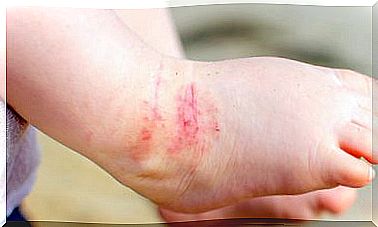Fetal Valproic Acid Syndrome
Fetal valproic acid syndrome is known as the set of congenital alterations suffered by newborns exposed to valproic acid during pregnancy. It appears in 5-10% of fetuses exposed to this drug.
Valproic acid and pregnancy
Valproic acid is an anticonvulsant drug indicated in the treatment of epilepsy. It is also useful in preventing migraines and is part of the treatment of bipolar disorder. Once in the body, valproic acid crosses the placental barrier, reaching higher concentrations in the fetus than in the mother.
It is a teratogenic agent, that is, it produces malformations. That is why its use in pregnancy should be limited to those cases in which its use is essential.
However, it should not be withdrawn immediately upon becoming pregnant, it must be consulted with the doctor and he should be the one who schedules the withdrawal. Otherwise, the consequences for the mother and the fetus can be fatal.
Fetal valproic acid syndrome clinic

Fetal valproic acid syndrome appears in fetuses that are exposed to valproic acid during the first trimester of pregnancy.
Given that most of the fetal organs and tissues develop during this period, the clinical manifestations are very varied. Likewise, not all children exposed to valproic acid present alterations. The main features of this alteration are:
- Characteristic facial features. These children will have a prominent and broad forehead. The middle part of the face is smaller than normal, that is, it is hypoplastic. Additional folds can appear on the eyelids known as epicanths, in addition to excessively separated and sparsely populated eyebrows. The space between the nose and the upper lip is enlarged, and the lower lip may be thickened. The corners of the mouth may appear sloping downward.
- Neural tube defects. The most common disorder is open spina bifida, in which the neural tube does not close at the appropriate time in development. The consequence is that nerve tissue comes out of the spine, usually at the lumbar level. This damages the nerve roots, so it can cause paralysis of the lower limbs and alterations in the sphincters.
- Genital abnormalities. The most common are in male newborns:
- Cryptorchidism: the testicles have not descended, so the scrotal bag is empty.
- Hypospadia: the opening of the urethra is not at the tip of the penis but at the base of the penis or in another abnormal location.
- Heart defects, such as alterations in the septum that separates the ventricles.
- Limb alterations.
- Developmental delay and other neuropsychological disorders. These children are at increased risk for attention deficit disorder (ADD) and other disorders of psychomotor development.
Diagnosis of fetal valproic acid syndrome

The suspected diagnosis is given by the clinical manifestations that we have commented on in children of mothers treated with valproic acid. Prenatal diagnosis is possible, detecting some of the alterations described. Ultrasound checks during pregnancy allow us to observe some of them, such as spina bifida. Heart problems can also be diagnosed with a fetal echocardiogram.
Prevention and treatment of fetal valproic acid syndrome

To prevent the development of fetal valproic acid syndrome, the administration of valproic acid should be avoided during pregnancy. In cases where treatment for the mother is essential, it is necessary to ensure that the doses are as low as possible. The administration of folic acid at high doses is recommended during the first trimester of pregnancy, since it reduces the probability of developing spina bifida.
If the syndrome appears, the diagnosis should be as early as possible. Structural alterations will be treated according to their management protocols. For example, if the child is born with open spina bifida, the treatment is emergency surgery that must be performed in the first 6 hours of life.
On the other hand, if alterations in psychomotor development appear during the child’s development, a correct psychotherapeutic approach is important so that the consequences are minimal.









